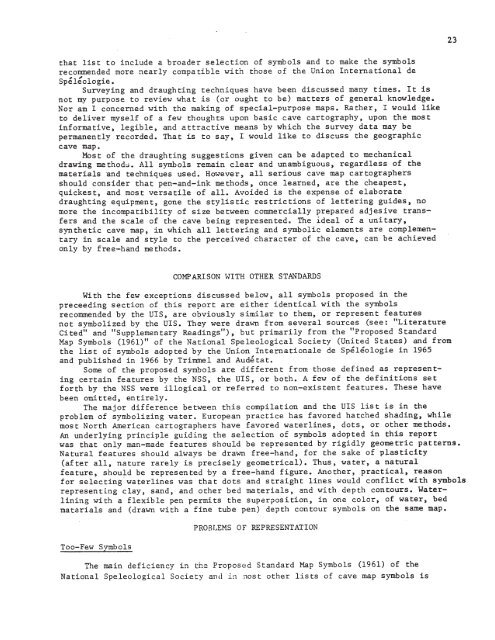asscciation for mexican cave studies box 7672 ut station austin ...
asscciation for mexican cave studies box 7672 ut station austin ...
asscciation for mexican cave studies box 7672 ut station austin ...
- No tags were found...
You also want an ePaper? Increase the reach of your titles
YUMPU automatically turns print PDFs into web optimized ePapers that Google loves.
23that list to include a broader selection of symbols and to make the symbolsrecommended more nearly compatible with those of the Union International deSpeleologie.Surveying and draughting techniques have been discussed many times. It isnot my purpose to review what is (or ought to be) matters of general knowledge.Nor am I concerned with the making of special-purpose maps. Rather, I would liketo deliver myself of a few thoughts upon basic <strong>cave</strong> cartography, upon the mostin<strong>for</strong>mative, legible, and attractive means by which the survey data may bepermanently recorded. That is to say. I would like to discuss the geographic<strong>cave</strong> map.Most of the draughting suggestions given can be adapted to mechanicaldrawing method~. All symbols remain clear and unambiguous, regardless of thematerials and techniques used. However. all serious <strong>cave</strong> map cartographersshould consider that pen-and-ink methods. once learned, are the cheapest,quickest, and most versatile of all. Avoided is the expense of elaboratedraughting equipment, gone the stylistic restrictions of letEering guides, nomore the incompatibility of size between commercially prepared adjesive transfersand the scale of the <strong>cave</strong> being represented. The ideal of a unitary,synthetic <strong>cave</strong> map, in which all lettering and symbolic elements are complementaryin scale and style to the pe~ceived character of the <strong>cave</strong>, can be achievedonly by free-hand methods.COMPARISON WITH OTHER STANDARDSWith the few exceptions discussed below, all symbols proposed in thepreceeding section of this report are either identical With the symbolsrecommended by the UIS, are obviously similar to them, or represent featuresnot symbolized by the UIS. They were drawn from several sources (see: "LiteratureCited" and "Supplementary Readings"), b<strong>ut</strong> primarily from the "Proposed StandardMap Symbols (1961)" of the National Speleological Society (United States) and fromthe list of symbols adopted by the Union Internationale de Speleologie in 1965and published in 1966 by Trimmel and Audetat.Some of the proposed symbols are different from those defined as representingcertain features by the NSS, the VIS, or both. A few of the definitions set<strong>for</strong>th by the NSS were illogical or referred to non-existent features. These havebeen omitted, entirely.The major difference between this compilation and the UIS list is in theproblem of symbolizing water. European practice has favored hatched shading, whilemost North American cartographers have favored waterlines, dots, or other methods.An underlying principle guiding the selection of symbols adopted in this reportwas that only man-made features should be represented by rigidly geometric patterns.Natural features should always be drawn free-hand, <strong>for</strong> the sake of plasticity(after all, nature rarely is precisely geometrical). Thus, water, a naturalfeature, should be represented by a free-hand figure. Another, practical, reason<strong>for</strong> selecting'waterlines was that dots and straight lines would conflict with symbolsrepresenting clay, sand, and other bed materials, and with depth contours. Waterliningwith a flexible pen permits the superposition, in one color, of water, bedmatarials and (drawn with a fine tube pen) depth contour symbols on the same map.PROBLEMSOF REPRESENTATIONToo-Few SymbolsThe main deficiency in the Proposed Standard Map Symbols (1961) of theNational Speleological Society and in :aost other lists of <strong>cave</strong> map symbols is
















